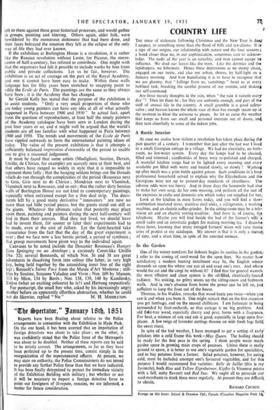ART
THE fifth column has struck and the enemy are within the gates. Behind locked doors the surrender was made. Not a shot wos fired, not a bridge blown. Overnight they appeared, ranged them- selves in ordered rows through those hallowed precincts, and took possession of the very citadel itself. I studied the faces of the onlookers. Some, a little fearful, thought it best to pretend that nothing had happened and went about their business with unseeing eyes. Others, simpler souls, felt that ridicule was a weapon still
left to them against these great historical processes, and would gather in groups, pointing and tittering. Others again, older folk, were bewildered by the monstrous dishonour that had been done, and their faces betrayed the emotion they felt at the eclipse of the only way of life they had ever known.
If the exhibition at Burlington House is a revolution, it is rather like the Russian revolution without Lenin, for Picasso, the storm- centre of half-a-century, has refused to contribute. One might wish that the organisers had felt it possible to include works by him from public and 'private collections. Let us be fair, however. The exhibition is an act of courage on the part of the Royal Academy, and one it cannot have been easy to make. Within these walls language has for fifty years been stretched to snapping point to vilify the Ecole de Paris. The paintings are the same as they always have been ; it is the Academy that has changed.
Sir Gerald Kelly has stated that the purpose of the exhibition is to assist students. " Only a very small proportion of those who are today young painters can have any idea at all of what actually happened in Paris between 1900 and 1950 " In actual fact, apart from the question of reproductions, at least half the ninety painters of the Academy catalogue have been seen in London during the past four years or so, and it might well be argued that the world's students are all too familiar with what happened in Paris between 1900 and 1950. The trends and movements of the Ecole de Paris have rippled outwards to form the international painting idiom of today. The value of the present exhibition is that it attempts a sufficiently balanced impression d'ensemble of the period to enable one to give a reasoned judgement.
It must be faced that some artists (Modigliani, Soutine, Derain, Utrillo, de Chirico, for example) are scarcely seen at their best, and that others have ranged so widely in style that it is impossible to represent them fully ; that the hanging seldom brings out the threads which do run through the complexities of the period (Rousseau next to Gris, Gris next to de Chirico ; Mondrian next to Vlaminck, Vlaminck next to Rousseau, and so on) ; that the rather dirty hessian walls of Burlington House arc not kind to contemporary paintings, especially when unframed except for a thin deal strip. The docu- ments left by a good many derivative " innovators " are now no more than sad little period pieces, but the giants stand out still as
the giants. Whatever the ultimate value that posterity may place
upon them, painting and painters during the next half-century will find in them their sources. Had they not lived, we should have
had to invent them, fOr sooner or later their experiments had to be made, even at the cost of failure. Let the faint-hearted take reassurance from the fact that the day of the great experiment is over ; that we face now a less heroic period, a period of synthesis ; that group movements have given way to the individual again.
Canvases to be noted include the Douanier Rousseau's Hungry Lion Springing on an Antelope ; a curiously Corot-like Utrillo (No. 32); several Bonnards, of which Nos. 36 and 38 are great adventures in dissolving form into colour (the latter, in very high key, being held together by the astonishing inner line of the right leg); Rouault's Sainte Face from the Muse.e d'Art Moderne ; still- hies by Soutine, Suzanne Valadon and Vivin ; Nos. 109 by Masson, 113. by Miro, 134 by Bores ; Nos. 138, 139, 140 by Kandinsky, Esteve (what an exciting colourist he is!) and Hartung respectively. For postscript, the small boy who, asked by his increasingly angry mother before an apparently effortless abstraction, whether he could



































 Previous page
Previous page